
SALTICAM: the SALT imaging and acquisition camera
Introduction
SALTICAM was designed as a multi-purpose device, acting as the telescope acquisition camera as well as a science imager/photometer. It is situated at the prime focus, but fed by a 45° fold mirror. SALTICAM was built at the SAAO with D. O'Donoghue as PI.
It is a simple instrument with the following functional flow:
- Fold mirror
- 7-element lens system
- Filter
- Shutter
- CCD cryostat
- CCD chips
- SDSU CCD Controller
- PC for instrument control, data display and disc storage
If you already know the instrument, SALTICAM detailed technical information can be found here.
Optics
The lens system reduces the SALT f/4.2 prime focal ratio to f/2, thereby enabling the ful 4-arcmin science field of view, as well as almost all of the guide star field of view, to be captured on the 2x1 CCD mosaic. The lenses are made from UV-transmitting crystals, and the CCDs have excellent UV performance, so the instrument is expected to be very efficient at short wavelengths. The optical design is illustrated below.
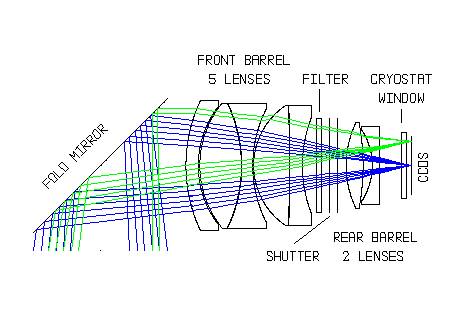
Fields Of View
The next illustration shows the fields of view superimposed on the detector and includes:
- The edge of the science field of view (inner circle)
- The edge of the guide star field of view (outer circle)
- The two rectangular CCD chips separated by a 1.5 mm gap
- The (horizontal) frame transfer boundary
- The (vertical) boundary between the two halves on each chip read out by different reaout amplifiers
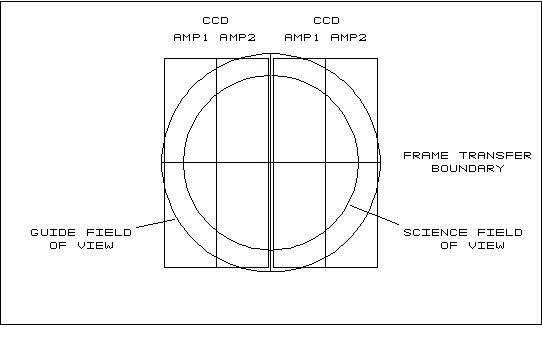
The CCD Detectors
The detector is a 2x2 mosaic of 2kx4kx15 micron pixel CCD 44-82 chips from E2V Technologies. These devices are thinned, back-illuminated and coated with the E2V Astro Broad Band coating. They are also deep-depletion devices for better near-infrared sensitivity and lower fringing. A schematic of one of the chips is shown below.
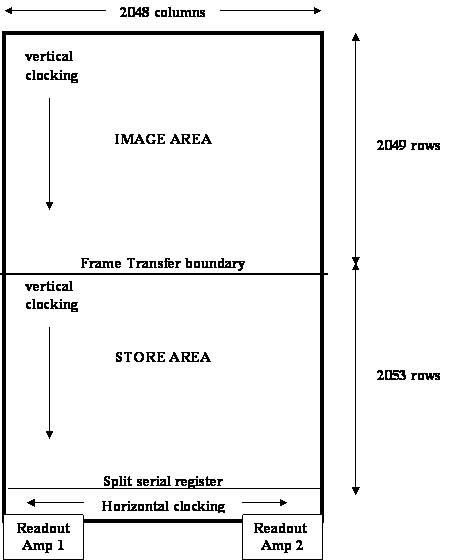
An example raw SALTICAM frame is shown below. The two CCDs with the 1.5 mm gap between them are obvious. Also obvious are the two amplifiers in each chip (with different bias levels) and the vignetting of the field in the corners. Image quality at the time of this image was not optimal, which accounts for the poor star images at the edges.
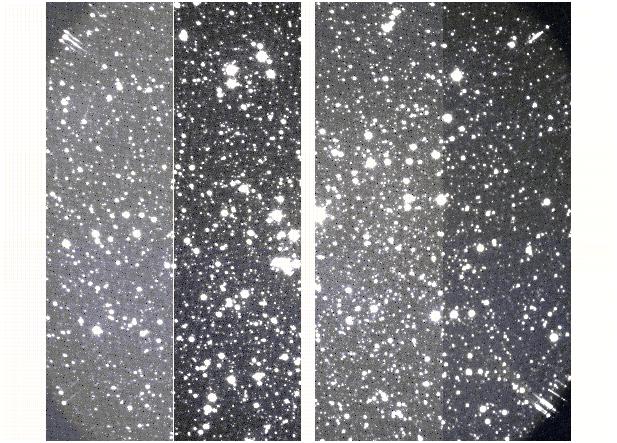
High Time Resolution
The illustrations below show how high time resolution
imaging can be obtained. For moderate time resolution (a few sec), frame
transfer operation is used. This is explained by the left hand diagram: a
mask (shown in grey) covers the lower half of each chip. At the end of
each exposure, the image in the top half of the chip is rapidly (200
millisec) shifted to the lower half where it is readout while the next
image in the top half accumulates during the next exposure.
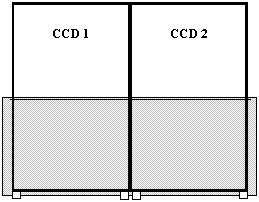 |
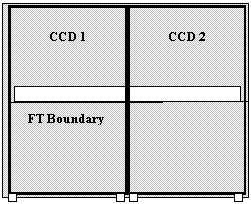 | |
Even faster sampling can be obtained with so-called slot mode: in this mode a mask is advanced over the entire chips except for a slot just above the frame transfer boundary. Instead of half frame transfers at the end of each exposure, 144 rows are moved and this allows exposure times as short as 100 millisec. The slot position is illustrated in the right hand diagram above and the readout scheme is shown in the illustration below.
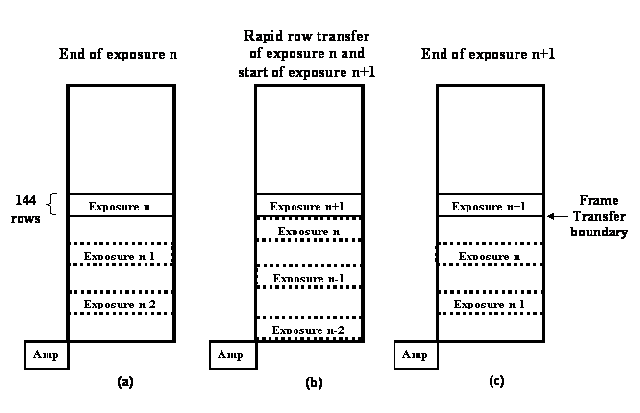
Of course both techniques require field of view to be sacrificed for time resolution: in frame transfer mode, half the field of view is lost; in slot mode, only the slot is available for imaging. The intended use of slot mode is to position a rapidly varying target star and a brighter nearby companion star in the slot to perform differential photometry of the variable with respect to the comparison star. See further discussion on photometry with SALTICAM below. The telescope rho stage can be rotated to locate comparison stars at arbitary position angles within the slot.
Implications Of Doing Photometry With SALTICAM
The moving pupil inherent to the basic operation of SALT presents special problems for doing photometry with SALTICAM. While it is true that if the tracker position is known at all times, the fraction of the primary mirror within the pupil can be calculated (including gaps between mirrors) and the photometric "response" function of the telescope can be worked out. However, this assumes equal reflectivity for all mirrors; clearly this will not be true and furthermore it will be variable as the cycle of mirror recoating runs. (Typically, at least one and possibly two segments per week will be recoated).
Measuring reflectivities of mirrors is an uncertain process so it seems very difficult to provide calibrations sufficient to estimate the response function to at least 1 per cent (preferably better) for all tracker positions.
So those carrying out photometry with SALTICAM should bear in mind:
- Relative photometry within the 8 arcmin science field should be unaffected by the pupil/primary mirror mismatch: all field angles will be equally affected by the mismatch. There is variable vignetting due to the SAC over the science field but this will be calibrated by the instrument team and provided for the data reduction. This vignetting should be constant in time. Thus programs requiring relative surface photometry of extended objects or relative photometry of point sources will be unaffected. Variability monitoring will require referencing the variable to one or more constant comparison stars within the field.
- Absolute photometry will, of course, not work because of the varying amount of pupil/primary mirror mismatch. Thus, absolute photometry will require referencing SALTICAM data to a measurement of at least one and preferably several point sources in the field on another telescope using the same filter system. SAAO is hoping to build a CCD camera for the Newtonian focus of its 1.9-m telescope to facilitate these supporting observations. Of course, if the magnitudes are known from other sources, this will suffice.
- Most accurate absolute photometry, especially at U, will require knowing the colour transformation equations for the SALTICAM filter system. Determining these is not a trivial task and will require observations of a cluster of stars with known and reliable photometry. The instrument team and SALT operations will provide this information but possibly not immediately for the P-V phase so observers who require very accurate absolute photometry should take this into account.